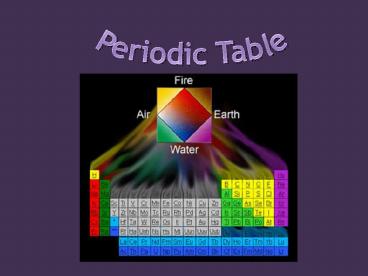Periodic Table - PowerPoint PPT Presentation
1 / 34
Title: Periodic Table
1
Periodic Table
2
Memorize these element names symbols
Gases
H hydrogen He helium Ne
neon N nitrogen O oxygen F
fluorine Cl chlorine Ar
argon
Liquids
Hg mercury
Br bromine
3
Solids
Li lithium B boron C
carbon Na sodium Mg
magnesium Al aluminum Si silicon
P phosphorus S sulfur K
potassium Ca calcium Cr chromium
Mn manganese Fe iron Co cobalt
Ni nickel Sn tin Cu
copper Zn zinc Pb
lead As arsenic I Iodine Se
selenium Ba barium Ag silver
Au gold Pt platinum U
uranium
4
Arrangement of the Elements
Russian, Dmitri Mendeleev created The first
accepted periodic table (1800s)
- Increasing
2)
5
3)
Identify the element in Group 2A, period
4 Group 7A, period 5 Group 1 B, period 4
6
4) Metal, Nonmetal, Metalloid
7
Properties of Metals
8
Properties of Nonmetals
xenon
sulfur
carbon
9
Properties of Metalloids (either side of zig zag
line)
Ex B, Si, Ge, As, Sb
silicon
used in semiconductor industry (computer chips)
10
5) Electron Arrangement
Quantum Theory revisited
Apartment building analogy
atom
apartment building
11
types of orbitals
( room apt.)
( room apt.)
( room apt)
( room apt)
12
Electron Configuration
Ex 1s22s22p6
13
Aufbau Diagram
1s2 2s2 2p6 3s2 3p6 3d10 4s2
4p6 4d10 4f14 5s2 5p6 5d10
5f14 6s2 6p6 6d10 6f14 7s2
7p6 7d10 7f14
14
sample electron configurations
H 1 e-
He 2e-
Li 3e-
N 7 e-
15
Fe 26e-
3p
1s
2s
2p
3s
16
Sample problem
Given the electron configuration
1s22s22p63s23p5
1. How many electrons are unpaired?
2. How many electrons are in the outermost energy
level ?
3. How many energy levels and sublevels are
occupied?
4. What element has this ground state
configuration?
17
Given the configuration 1s22s22p63s23p64s23d104p
3
this is the config. of
- How many electrons are in the outer energy
- level?
2. How many electrons are unpaired?
18
Short method for e- config.
Use noble gases
Ex Cl 17 e-
1st 10 e-
1st 18 e-
Ex Ba 56e-
1st 36 e-
Ex Zn 30 e-
1st 54 e-
1st 86 e-
U 92 e-
Si
Pd
14 e-
46 e-
19
using the periodic table to write electron
configurations
1
2
3
4
5
6
7
6
7
20
Ex Na
Ne
3s1
Ex P
Ne
3s2
3p3
Ex Co
Ar
4s2
3d7
Ex Sn
Kr
5s2
4d10
5p2
Ex Pu
Rn
7s2
4f6
1. calcium
Ar 4s2
2. chlorine
Ne 3s2 3p5
3. cadmium
Kr 5s2 4d10
21
Families of Elements
22
Group 1A Alkali metals
Li
He
Na
Ne
K
Ar
Rb
always found combined in nature
Cs
Fr
react with water producing
23
Group 2A Alkaline Earth Metals
Be
He
all have ____ valence electrons
Mg
Ne
Ca
Ar
Sr
Ba
Ra
Also react w/ water to produce
24
Group 7A Halogens
F
He
Cl
Ne
all have ____valence e-
Br
Ar
I
At
form ____________ when combined with metals ex
always found in compounds
25
Group 8 A Noble Gases
He
Ne
He
most have ___ valence e-
Ar
Ne
Kr
Chemically inert
Xe
Rn
26
Transition Metals
(B groups)
unique property
typical metals
27
Inner Transition elements
_________________ series
____________________ series
La
Ac
28
Periodicity
Trend
atomic radius, ionization energy,
electronegativity
change from top to bottom down a group
Change from left to right across the row
29
- Atomic Radius
Indicates the ___________ of an atom
Group trend
more_______________ makes the atoms larger
Li 2 energy levels
K 4 energy levels
30
Periodic trend
more __________________makes the nucleus more
_________________pulling the _________________in
closer makes the atom _________________
Li
C
Ne
arrange these atoms from smallest to largest
Sr, Ne, Ca, S, Al
31
III. Ionization Energy
Li
K
Group trend
32
________________ across increase in
___________________(more p) causes electrons to
be held ____________ _______________
Periodic trend
Na
Al
Cl
Ex Which will lose an electron the easiest?
K or Ge ?
Mg or Ba ?
Al or Cs ?
33
IV. Electronegativity
Number from ________ that indicates an atoms
attraction ___________
F 4.0
Cs 0.7
group trend
Periodic trend
Ex Arrange these atoms from greatest attraction
for e- to least P, Al, Sr, O
34
trends summary































